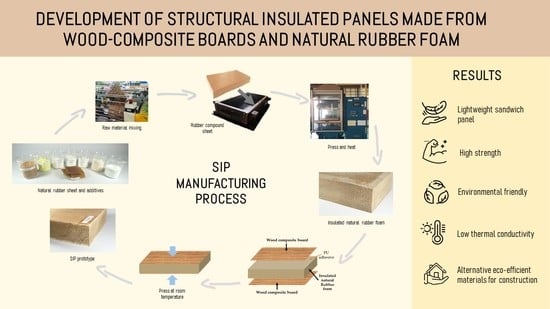Development of Structural Insulated Panels Made from Wood-Composite Boards and Natural Rubber Foam
Abstract
:1. Introduction
2. Materials and Methods
2.1. Raw Materials
2.2. Investigation of the Surface and Core Material Properties
- Density test: The density with the specimen dimension of 100 mm × 100 mm × board thickness was measured following ASTM D1037-12 [10].
- Thickness swelling and water absorption test: The swelling of the specimen and water absorption properties were observed with the specimen dimension of 152 mm × 152 mm × board thickness. The specimens were immersed in water at 20 °C for 24 h following ASTM D1037-12 [10].
- Thermal conductivity test: The thermal conductivity of the specimen was measured from specimens with a dimension of 50 mm × 50 mm × board thickness at 25 °C using a Thermal Constant Analyzer (TPS 2500S Hot Disk, Hot Disk AB, Gothenburg, Sweden) according to the standard ISO 22007-2:2015 [11].
- Fire resistance test: The specimens with a dimension of 12 mm × 125 mm × board thickness were tested in a UL94 Horizontal/Vertical Flame Chamber according to ASTM D3801-10 [12].
- Three-point static bending test: The structural bending properties of the specimen were tested using the methods stated in ASTM D1037-12 [10], using a 10 kN Universal Testing Machine. Each test specimen had a nominal width of 50 mm. The length of each specimen was 51 mm plus 24 times the nominal thickness. Modulus of Rupture (MOR) and Modulus of Elasticity (MOE) values were calculated for each specimen.
- Compression test parallel to the surface: The compressive strength parallel to the surface of the board was measured following ASTM D1037-12 [10] (Method A: Laminated Specimen). Each wood composite board was cut into the test specimens which were 25 mm (width) × 102 mm (length) × board thickness. Polyurethane adhesive was mixed following the supplier’s suggestion, as present in Table 3, and spread out on a single glue surface with an adhesive content of 150 g/m2 using a hand brush. Two pieces of board were pressed together in a clamping device at a pressure of 3 N/mm2 and room temperature until the adhesive cured (approximately 24 h). After that, the specimen was test using a 150 kN Universal Testing Machine. The compressive strength (Rc) and Modulus of Elasticity in compression parallel to the surface of the board (E) of each specimen were calculated.
- Cellular structure dimensions of the natural rubber foam, such as cell shape and size, were determined by an optical microscope (ZEISS (Jena, Germany), Axioskop 2 MAT).
- Density was measured from specimens with a dimension of 50 mm × 50 mm × 80 mm following ASTM D1622-14 [13].
- Thermal conductivity was measured from specimens with a dimension of 50 mm × 50 mm × 10 mm at 25 °C using a Thermal Constant Analyzer (TPS 2500S Hot Disk, Hot Disk AB, Gothenburg, weden) according to the standard ISO 22007-2:2015 [11].
- The fire resistance test with the specimen dimension of 12 mm × 125 mm × 10 mm was performed in a UL94 Horizontal/Vertical Flame Chamber according to ASTM D635-10 [14].
- Flexural tests were performed following ASTM D 790-17 [15] to measure flexural strength. Each test specimen was sized at 50 mm (width) × 340 mm (length) × 80 mm (core thickness) at a test span of 290 mm. The testing was conducted using a 10 kN Universal Testing Machine. The test results obtained the flexural strength at 5% deformation. When the natural rubber foam, which is a homogeneous elastic material, was tested in flexure as a simple beam supported at two points and loaded at the midpoint, the flexural stress () and the flexural strain () were calculated for any point on the load-deflection curve.
- Compression tests were conducted by following ASTM D1621-16 [16]. Each test specimen was sized nominally at 50 mm × 50 mm × 80 mm. The test results obtained the compressive strength at 10% deformation. The compressive stress () and the compressive strain () were calculated for any point on the load-deflection curve.
2.3. Manufacture of SIP Prototypes
2.4. Analysis of SIP Prototype Properties
- Density with the specimen dimension of 100 mm (width) × 100 mm (length) × 100 mm (panel thickness) was measured following ASTM D1037-12 [10].
- Thickness swelling and water absorption with the dimension of 152 mm (width) × 152 mm (length) × 100 mm (panel thickness), in which the specimens were immersed in water at 20 °C for 24 h, were determined in accordance with ASTM D1037-12 [10].
- Thermal transmittance (U) is a measure of heat flow through a material usually expressed in terms of thermal resistance (R). Usually, the transmittance is the inverse of resistance. Therefore, the U value of each panel could be expressed as the reciprocal of the summation of thermal resistances of all components (∑R). Hence, it was calculated from Equations (1) and (2):where R is the thermal resistance of the material, t is the sample thickness, and λ is the thermal conductivity of the material.
- Screw withdrawal resistance was determined for the face side of the specimen with the dimension of 76 mm (width) × 102 mm (length) × 100 mm (panel thickness) in accordance to ASTM D1037-12 [10] with some modifications and by using countersunk self-drilling screws with a root diameter of 3 mm. This screw type can be used with plywood, cement particleboard, and fiber-cement board.
- A three-point bending test was carried out for the SIP specimens with a dimension of 50 mm (width) × 340 mm (length) × 100 mm (panel thickness) at a test span of 290 mm. The testing method was performed with some modifications to ASTM D7250-20 [18] because the specimen length was shorter than the standard requirement. The testing was conducted using a 150 kN Universal Testing Machine, as illustrated in Figure 5. The load and the respective deflection were recorded. The bending stiffness and the fracture behavior of the sample were analyzed.
2.5. Statistic Analysis
3. Results
3.1. Properties of the Surface Materials
3.2. Properties of the Core Material
3.3. Properties of the SIP Prototypes
4. Conclusions
- SIP with a density ranging from 0.53 to 0.56 g/cm3 can be efficiently made from natural rubber foam core sandwiched between wood-based panels.
- Surface materials play a significant role in the properties of the SIP prototypes created in this study. The SIP covered with the cement particleboard and fiber cement board revealed high mechanical properties and high water resistance. The SIP prototype covered with the plywood showed desirable properties (such as low density, high resistance of screw withdrawal, and low thermal transmittance).
- SIPs made from wood-composite boards and natural rubber foam core could be alternative eco-efficient materials used in construction.
5. Recommendations
- Some components of SIP, particularly those constructed with plywood and natural rubber foam core, do not have sufficient fire resistance. Buildings constructed with SIPs may put occupants at a high risk of burns and smoke inhalation. The use of cost-effective fire retardants to increase fire resistance can minimize this problem.
- Moisture, mold, and rot problems with SIP panels can occur, particularly if using surfaces made of plywood. It can be improved using panels with waterproof surfaces, like fiber-cement board or cement particleboard, as mentioned before. Moreover, SIPs should be protected from moisture and direct exposure to weather conditions by an approved water-resistive barrier and a weather-resistive covering.
- Moisture content has a crucial impact that greatly affects the behavior of SIP. Analytical/numerical models should be used to predict the effects of moisture content on the strength and structural stability of SIP.
- Insects can be a problem for SIP because foam and plywood provide an optimal environment for insect infestation. An insecticide should be applied within the foam core and plywood to treat for insects.
- Since the effect of specimen size influences the mechanical properties of SIP, full-scale tests on SIP behavior, particularly bending strength, bending stiffness, and compression under transverse load, must be considered.
- Investigation of the structural qualification of the SIP prototypes should be conducted for ultimate and serviceability limit state design requirements.
- Because of the low value of stiffness of the SIP prototypes, the surface layers having a higher MOE value should be used to improve this property.
Author Contributions
Funding
Institutional Review Board Statement
Informed Consent Statement
Data Availability Statement
Acknowledgments
Conflicts of Interest
References
- Smakosz, Ł.; Tejchman, J. Evaluation of strength, deformability and failure mode of composite structural insulated panels. Mater. Des. 2014, 54, 1068–1082. [Google Scholar] [CrossRef]
- Panjehpour, M.; Ali, A.A.A.; Voo, Y.L. Structural Insulated Panels: Past, Present, and Future. J. Eng. Proj. Prod. Manag. 2013, 3, 2–8. [Google Scholar] [CrossRef] [Green Version]
- Karlsson, K.F.; TomasÅström, B. Manufacturing and applications of structural sandwich components. Compos. Part A Appl. Sci. Manuf. 1997, 28, 97–111. [Google Scholar] [CrossRef]
- Chandrasekaran, V.C. Rubber as a Construction Material for Corrosion Protection: A Comprehensive Guide for Process Equipment Designers; Wiley-Scrivener Publishing: Beverly, MA, USA, 2010. [Google Scholar]
- Phohchuay, P.; Khongtong, S. Insulated sandwich panels from natural rubber and rubber wood. Srinakharinwirot Sci. J. 2008, 34, 31–44. [Google Scholar]
- Wisadsatorn, S.; Phohchuay, P. Utilization of sandwich insulated panels made from wood composite and cellular natural rubber. Srinakharinwirot Sci. J. 2008, 34, 18–30. [Google Scholar]
- Particleboards. Definition and Classification. EN 309. 27 July 2005.
- Youngquist, Y.A. Wood-based composites and panel products. In Wood Handbook-Wood as an Engineering Material; Risbrudt, C.D., Ritter, M.A., Wegner, T.H., Eds.; USDA Forest Service: Madison, WI, USA, 1999; pp. 10.1–10.31. [Google Scholar]
- Khongtong, S.; Chaowana, P.; Wisadsatorn, S.; Srivaro, S. Energy-saving SIP made from natural rubber. In Full Research Report for the Energy Policy and Planning Office, Ministry Report No. EE-PSU-60-01; Walailak University: Nakhonsithammarat, Thailand, 2018. [Google Scholar]
- ASTM D1037. Standard Test Methods for Evaluating Properties of Wood-Base Fiber and Particle Panel Materials. 1 December 2020.
- EN ISO 22007-2. Plastics Determination of Thermal Conductivity and Thermal Diffusivity, Part 2 Transient Plane Heat Source (Hot Disc) Method. 1 August 2015.
- ASTM D3801-10, Standard Test Method for Measuring the Comparative Burning Characteristics of Solid Plastics in a Vertical Position; ASTM International: West Conshohocken, PA, USA, 1 August 2010.
- ASTM D1622. Standard Test Method for Apparent Density of Rigid Cellular Plastics. 1 August 2014.
- ASTM D635. Standard Test Method for Rate of Burning and/or Extent and Time of Burning of Plastics in a Horizontal Position. 1 August 2018.
- ASTM D790. Standard Test Methods for Flexural Properties of Unreinforced and Reinforced Plastics and Electrical Insulating Materials. 1 October 2017.
- ASTM D1621. Standard Test Method for Compressive Properties of Rigid Cellular Plastics. 1 August 2016.
- Fernando, P.L.N.; Jayasinghe, M.T.R.; Jayasinghe, C. Structural feasibility of expanded polystyrene (EPS) based lightweight concrete sandwich wall panels. Constr. Build. Mater. 2017, 139, 45–51. [Google Scholar] [CrossRef]
- ASTM D7250. Standard Practice for Determining Sandwich Beam Flexural and Shear Stiffness. 15 March 2020.
- Gibson, L.J.; Ashby, M.F. Cellular Solids: Structure and Properties; Pergamon Press: Oxford, UK, 1998. [Google Scholar]
- Allen, H.G. Analysis and Design of Structural Sandwich Panels; Pergamon Press: London, UK, 1969. [Google Scholar]
- Emmitt, S.; Gose, C.A. Introduction to Construction of Buildings, 3rd ed.; John Wiley & Sons, Ltd.: Chichester, West Sussex, UK, 2014. [Google Scholar]
- Avramidis, S.; Lau, P. Thermal coefficients of wood particles by a transient heat-flow method. Holzforschung 1992, 46, 449–453. [Google Scholar] [CrossRef]
- Srivaro, S.; Chaowana, P.; Matan, N.; Kyokong, B. Lightweight sandwich panel from oil palm wood core and rubberwood veneer face. J. Trop. For. Sci. 2014, 26, 50–57. [Google Scholar]
- Sauvat, N.; Sell, R.; Mougel, E.; Zoulalian, A. A study of ordinary Portland cement hydration with wood by isothermal calorimetry. Holzforschung 1999, 53, 104–108. [Google Scholar] [CrossRef]
- Wei, Y.M.; Tomita, B.; Hiramatsu, Y.; Miyatake, A.; Fujii, T.; Fugii, T.; Yoshinaga, S. Hydration behavior and compressive strength of cement mixed with exploded wood fiber strand obtained by the water-vapor explosion process. J. Wood Sci. 2003, 49, 317–326. [Google Scholar] [CrossRef]
- Chaowana, P. Acidity and solubility of rubberwood and their impacts on the curing behavior of urea–formaldehyde resin. J. Trop. For. Sci. 2016, 28, 32–38. [Google Scholar]
- Jiao, C.; Chen, X.; Zhang, J. Synergistic flame-retardant effects of Aluminum Oxide with layered double Hydroxides in EVA/LDH Composites. J. Thermoplast. Compos. Mater. 2010, 23, 501–512. [Google Scholar] [CrossRef]
- Petrova, N.P.; Ushmarin, N.F.; Gnezdilov, D.O.; Kol’tsov, N.I. The development of a flame-retardant rubber compound based on general-purpose rubbers. Int. Polym. Sci. Technol. 2016, 43, 15–18. [Google Scholar] [CrossRef]
- Lee, S.T.; Park, C.B.; Ramesh, N.H. Polymeric Foam; Taylor and Francis Group: London, UK, 2007. [Google Scholar]
- Yang, J.; Li, Z.; Du, Q. An experimental study on material and structural propertie of Structural Insulated Panels (SIPs). Appl. Mech. Mater. 2012, 147, 127–131. [Google Scholar] [CrossRef]
- Roesler, R.; Harders, H.; Baeker, M. Mechanical Behavior of Engineering Materials: Metals, Ceramics, Polymers, and Composites; Springer: Berlin, Germany, 2007. [Google Scholar]


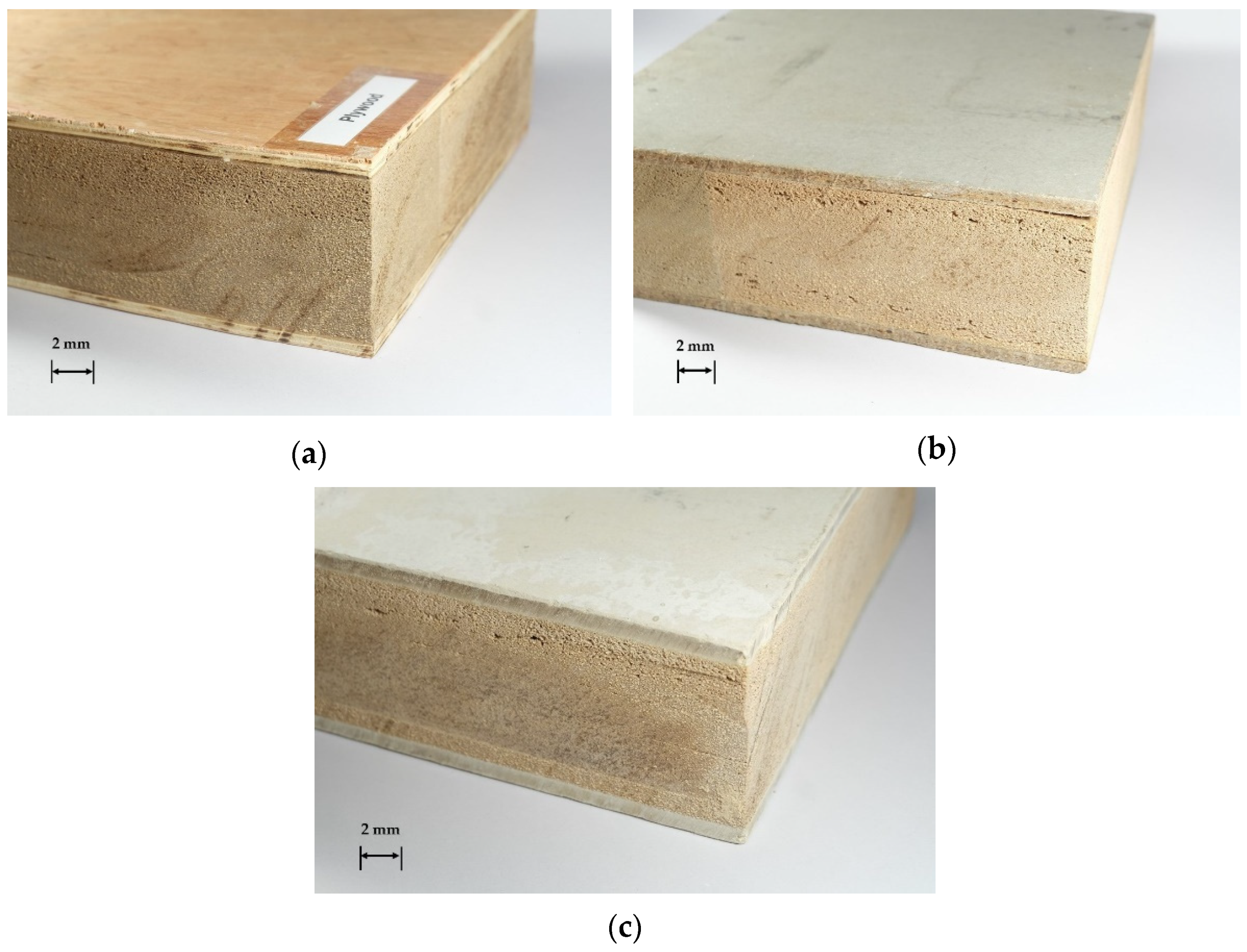

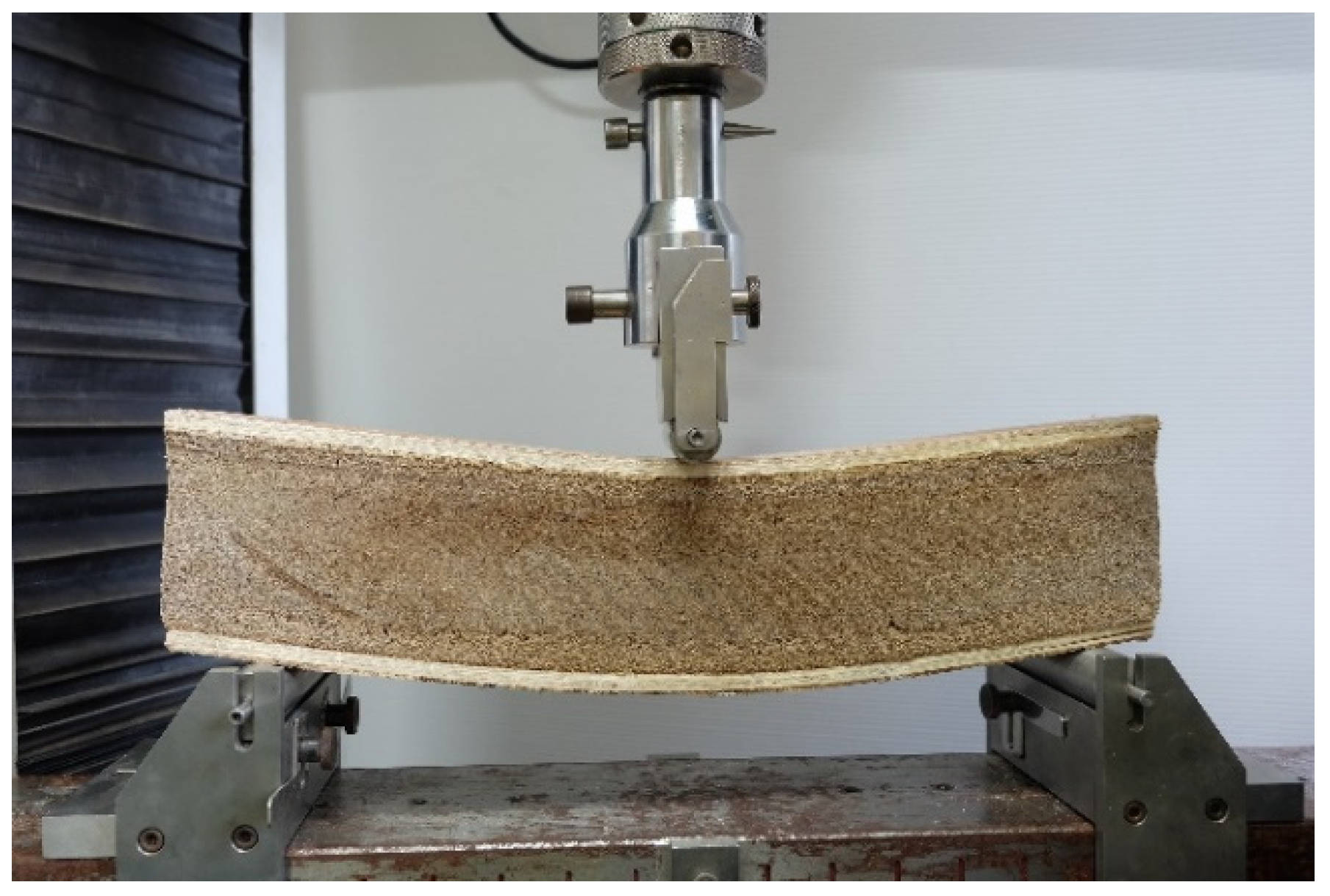

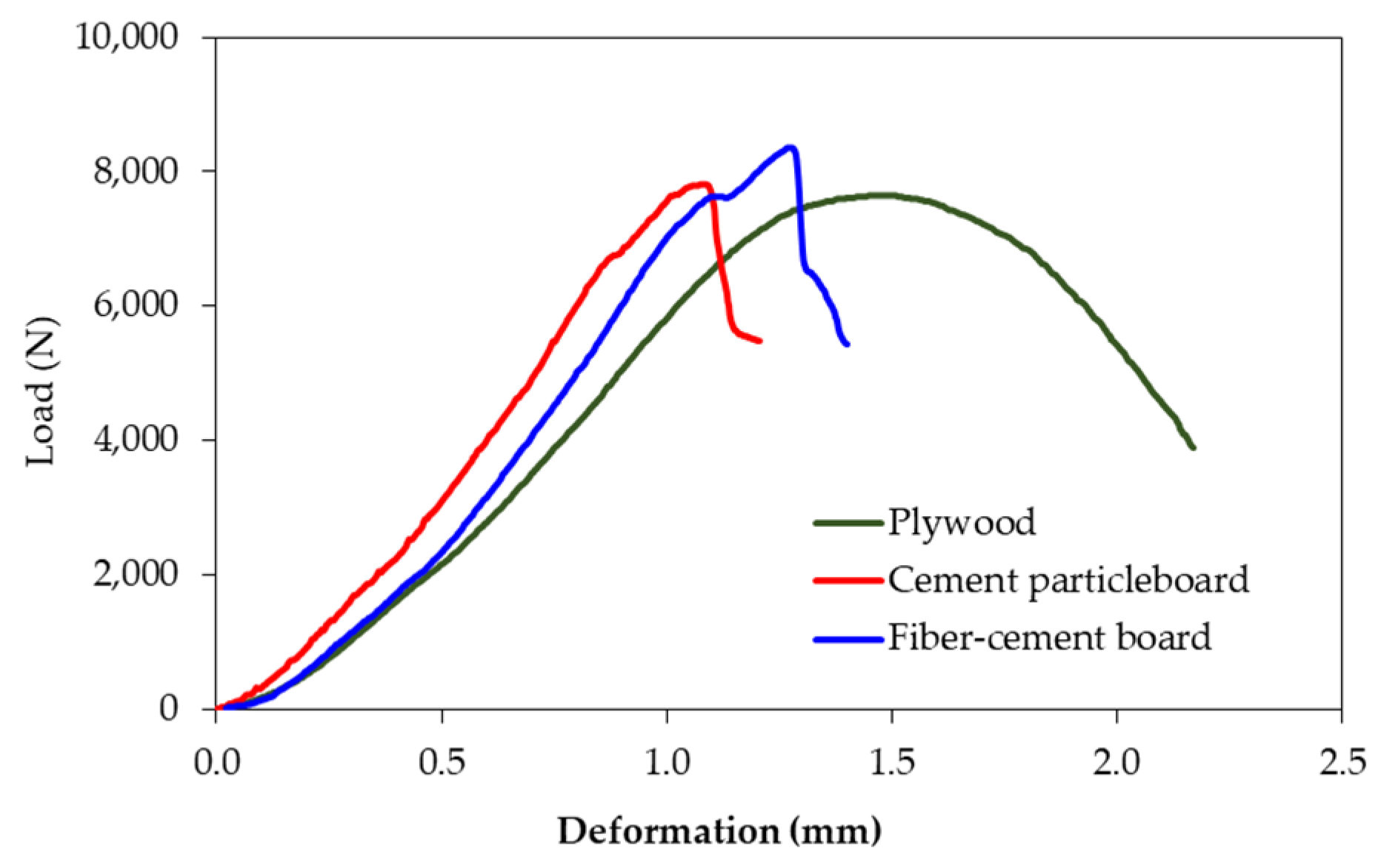


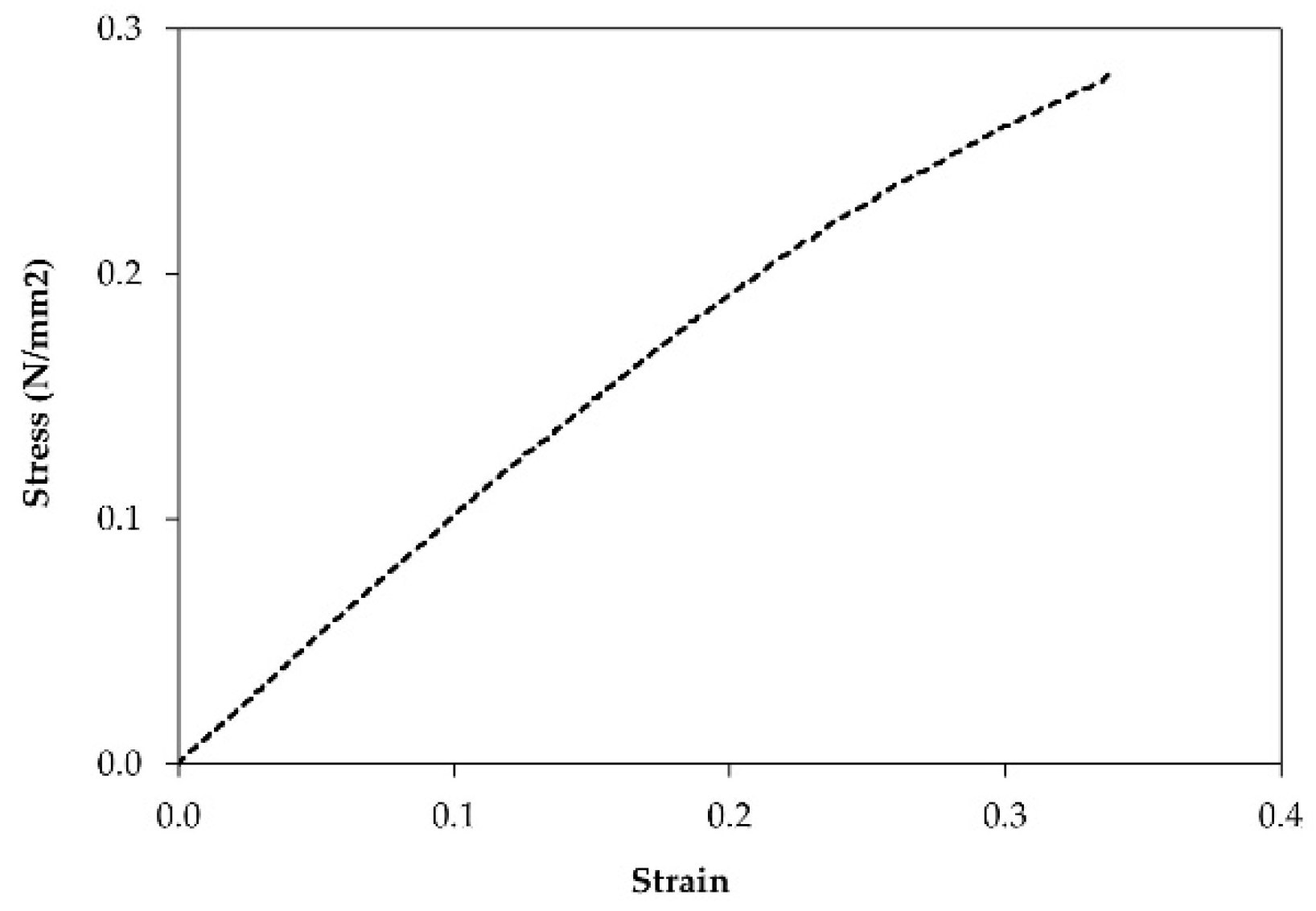



| Surface Materials | Thickness (mm) | Width (mm) | Length (mm) |
|---|---|---|---|
| Plywood | 8.46 | 1200 | 2400 |
| Cement particleboard | 7.82 | 1200 | 2400 |
| Fiber-cement board | 7.62 | 1200 | 2400 |
| Components | phr | Components | Manufacturer |
|---|---|---|---|
| Natural rubber | 100 | Natural rubber | - |
| Stearic acid | 2 | Activator | Aldrich, St. Louis, MI, USA |
| Zinc oxide | 2 | Activator | Aldrich, St. Louis, MI, USA |
| Supercell-promotor | 1.5 | Kicker | A.F. Supercell, Bangkok, Thailand |
| Oxybis benzene sulfonyl hydrazide | 5 | Blowing agent | Merck, Kenilworth, NJ, USA |
| Zinc-N-diethyldithiocarbamate | 1 | Accelerator | Aldrich, St. Louis, MI, USA |
| Dibutylated Hydroxytoluene | 1 | Antioxidant | Aldrich, St. Louis, MI, USA |
| Sulfur | 2 | Crosslinker | Merck, Kenilworth, NJ, USA |
| Properties | Unit | GSP PU 902 | GSP PU 902H |
|---|---|---|---|
| Chemical type | - | Polyol | Isocyanate |
| Appearance | - | Gray slurry | Brown liquid |
| Viscosity (at 30 °C) | cps. | 700 | 200 |
| Specific gravity (at 30 °C) | g/cm3 | 0.98 | 1.20 |
| Mixing ratio | - | 5 | 1 |
| Properties | Surface Materials | ||
|---|---|---|---|
| Plywood | Cement Particleboard | Fiber-Cement Board | |
| Density (g/cm3) | 0.60 c,* (0.01) ** | 1.23 b (0.04) | 1.31 a (0.03) |
| Thickness swelling (%) | 5.32 a (2.53) | 2.90 b (1.12) | 1.62 b (0.60) |
| Water absorption (%) | 33.66 a (4.00) | 9.21 b (0.29) | 6.75 b (0.51) |
| Thermal conductivity (W/m·K) | 0.18 b (0.00) | 0.42 a (0.00) | 0.43 a (0.00) |
| Flammability by UL-94 classification *** | V-1 | V-0 | V-0 |
| Duration of self-sustained burning (Second) | 14.8 a (5.26) | 0.00 b (0.00) | 0.00 b (0.00) |
| Modulus of Rupture (N/mm2) | 32.31 a (0.97) | 10.72 b (0.23) | 9.93 b (0.69) |
| Modulus of Elasticity (N/mm2) | 3138.42 c (189.65) | 6714.63 a (139.68) | 4725.12 b (258.10) |
| Compression strength parallel to surface (N/mm2) | 20.87 a (2.29) | 18.98 a (2.21) | 20.11 a (2.08) |
| Modulus of Elasticity in compression parallel to surface of board (N/mm2) | 2165.45 b (116.51) | 2443.93 a (230.94) | 2544.98 a (394.43) |
| Properties | Core Material (Natural Rubber Foam) |
|---|---|
| Density (g/cm3) | 0.53 (0.03) * |
| Thermal conductivity (W/m·K) | 0.09 (0.00) |
| Flammability by UL-94 classification ** | HB |
| Burning rate (mm/min) | 38.21 (4.15) |
| Flexural strength at 5% deformation (N/mm2) | 0.05 (0.001) |
| Compressive strength at 10% deformation (N/mm2) | 0.14 (0.01) |
| Properties | SIPs Made from Natural Rubber for Core Covered with | Expandable Polystyrene Concrete Sandwich Wall | ||
|---|---|---|---|---|
| Plywood | Cement Particleboard | Fiber-Cement Board | ||
| Density (g/cm3) | 0.53 b,* (0.01) ** | 0.56 a (0.01) | 0.56 a (0.01) | 0.53 (0.00) |
| Thickness swelling (%) | 3.08 a (0.17) | 0.93 b (0.04) | 0.93 b (0.02) | 1.05 (0.03) |
| Water absorption (%) | 11.20 a (0.41) | 7.72 c (0.39) | 10.26 b (0.37) | 7.31 (0.20) |
| Thermal transmittance (W/m2·K) | 0.57 | 0.83 | 0.84 | 1.70 |
| Screw withdrawal resistance (N) | 1023.03 a (96.07) | 739.62 b (107.25) | 480.45 c (111.97) | 410.50 (51.93) |
| Stiffness (N/mm) | 33.41 c (1.13) | 41.66 a (2.59) | 36.54 b (1.10) | 283.69 (24.03) |
Publisher’s Note: MDPI stays neutral with regard to jurisdictional claims in published maps and institutional affiliations. |
© 2021 by the authors. Licensee MDPI, Basel, Switzerland. This article is an open access article distributed under the terms and conditions of the Creative Commons Attribution (CC BY) license (https://creativecommons.org/licenses/by/4.0/).
Share and Cite
Thongcharoen, N.; Khongtong, S.; Srivaro, S.; Wisadsatorn, S.; Chub-uppakarn, T.; Chaowana, P. Development of Structural Insulated Panels Made from Wood-Composite Boards and Natural Rubber Foam. Polymers 2021, 13, 2497. https://doi.org/10.3390/polym13152497
Thongcharoen N, Khongtong S, Srivaro S, Wisadsatorn S, Chub-uppakarn T, Chaowana P. Development of Structural Insulated Panels Made from Wood-Composite Boards and Natural Rubber Foam. Polymers. 2021; 13(15):2497. https://doi.org/10.3390/polym13152497
Chicago/Turabian StyleThongcharoen, Nussalin, Sureurg Khongtong, Suthon Srivaro, Supanit Wisadsatorn, Tanan Chub-uppakarn, and Pannipa Chaowana. 2021. "Development of Structural Insulated Panels Made from Wood-Composite Boards and Natural Rubber Foam" Polymers 13, no. 15: 2497. https://doi.org/10.3390/polym13152497






